One of the great keys to success in content marketing is knowing your audience. Here are a few tips to help you get past name, rank and serial number to more telling insights. In last month’s column, we talked about the basics of content marketing. Over the course of the next few months, I’d like to dive into the basics in more detail. We’ll start with your audience and getting to know them.
Know Your Audience
Just about any content marketing discussion starts with the audience. Quite simply, a good grasp of your audience is the foundation of content marketing – it’s not about you; it’s about them. Forget benefits, forget features, forget your products and services altogether. Instead, focus on content that is of interest to your audience. Content that answers the questions that keep them awake at night.

Answering those questions means knowing what questions they’re asking. And that means knowing them and their business. There are a variety of techniques we use for this:
- Personas
- Surveys and Polls
- Client Interviews
- Analytics
Creating Personas
Creating personas (Personae for those in academia or suffered through one year of Latin too many …) is an underutilized tool. That’s probably because it seems “touchy-feely” to talk about your audience’s motivations and behavior. But mapping that mindset invariably leads to insights about how to connect with the audience’s true interests.
Remember, the goal of content marketing – all marketing – is to encourage a desired behavior – click that buy button, join an email list, pick up the phone. So understanding behaviors is going to be time well spent.
There are no shortage of resources online for persona creation. I’ll leave it to you to do the search, but here are the basics.
- What are this person’s top three challenges?
- What are this person’s goals in solving those issues?
- What risks is this person facing in taking action? What risks do they face in doing nothing?
- What is this person’s biographical information–age, education, training, professional background, gender?
- How can this person best be reached? What do they read related to their jobs? What events do they attend?
Lastly, it pays to remember that you must create a persona for each audience segment.
Surveys and Polls
Another way to gain insights into your audience’s behavior and motivation is to run surveys and polls. These can be simple widgets on your website, like those available for various CMS (content management systems), or stand-alone applications like SurveyMonkey. Some email service providers are beginning to offer similar features.
Client Interviews
Though it’s tempting to interview just your “best” clients – and easier, since they’re most likely to be receptive to giving you their time–it’s important to interview as broad a range of clients as you can. Not just those that love you, recommend you, and have become brand ambassadors. But those who weren’t necessarily a great fit.
Clearly, we wouldn’t want to create personas based on less-than-optimal clients, but learning their perspective can help you shore up problem areas with your product/service line or improve communication about the value they offer. Interviews are time intensive, but worth the investment because of the real-world nature of the data you’re getting.
Analytics
Speaking of data, let’s not forget analytics. You can get to know your audience by their clicks. Data on email clickthrough and open rates, on website traffic and bounce rates, and on responses to any other measurable form of marketing communications (like direct mail) yield great insight into audience behavior. It tells you the content they’re most interested in.
The data aren’t infallible, but with a large enough sample size, they’re less prone to the kind of errors that interviews and personas can sometimes suffer from. A more- or less-skilled interviewer can skew results, as can well- or poorly-worded survey questions.
I would encourage you to make use of as many of these techniques as you have the time and budget for. Whichever you do use, however, will give you a much better understanding of your audience and how you can create content that will attract them by addressing the issues they’re facing.
We’ll dive into that content creation process next month.





